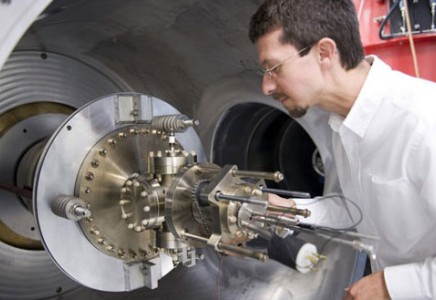Free-Electron Laser

Inspecting an injector assembly at Jefferson Lab's Free-Electron Laser
Additional Links
Jefferson Lab’s Free-Electron Laser is the world’s highest-power tunable infrared laser and was developed using the lab’s expertise in superconducting radiofrequency (SRF) accelerators. The FEL also provides ultraviolet laser light, including vacuum ultraviolet light, and is also a source of Terahertz light.
The FEL uses electrons to produce laser light. The electrons are energized using the lab’s superconducting accelerator technology and then steered into a wiggler.
The wiggler is a device that uses magnetic fields to shake the electrons, forcing them to release some of their energy as photons (light). As in a conventional laser, the photons are bounced between two mirrors and emitted as a coherent beam of light. The light can be tuned to precise colors or wavelengths because the electrons are freed of atoms, thus the name free-electron laser.
Jefferson Lab’s FEL has significant advantages compared to conventional lasers, making it possible, for instance, to produce intensely powerful light in brief bursts with extreme precision. The lack of a conventional lasing medium also allows the Free-Electron Laser to operate at very high power levels without overheating.
The uniqueness of Jefferson Lab’s Free-Electron Laser also stems from what it does with the electrons. It generates the electrons’ energy and then recovers it using a superconducting energy-recovering linac, or ERL. Jefferson Lab’s FEL is the first of a new generation of accelerator-based light sources in which each electron circulates only once rather than being stored as it would be in a typical synchrotron light source.

